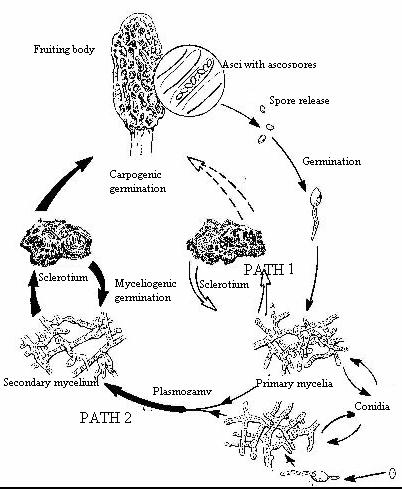Reproduction
Morchella esculenta is a fungus that follows a dikaryotic life cycle. In this life cycle, the only diploid phase is the very short sporophyte stage. The sporophyte of the morel is a very complex ascomycete structure. It is spongelike with many openings called apothecia that are raised above the ground to enable the dispersal of ascospores (Volk 1990). The ascospores will be released through the operculum and can be shot up to several meters away from the sporophyte for the life cycle to repeat itself. The ascospores that are released can be found within an ascus. An ascus is a sac-like structure that has been found to contain eight ascospores, which are the beginning of the life cycle of M. esculenta (Volk 1990).
 The life cycle starts out as a haploid ascospore produced from the
sporophyte. After the ascospores are released, they have been found
to germinate almost immediately (Volk 1990). After germination of
the ascospores, multinucleate hyphae begin to grow. From the
multinucleate hyphae growth there are two different ways that the
life cycle of M. esculenta can go, the deciding factor on which way
the life cycle will take is dependent upon when plasmogamy takes
place (Volk 1990).
The life cycle starts out as a haploid ascospore produced from the
sporophyte. After the ascospores are released, they have been found
to germinate almost immediately (Volk 1990). After germination of
the ascospores, multinucleate hyphae begin to grow. From the
multinucleate hyphae growth there are two different ways that the
life cycle of M. esculenta can go, the deciding factor on which way
the life cycle will take is dependent upon when plasmogamy takes
place (Volk 1990).
The first pathway will proceed to grow without undergoing
plasmogamy. The primary mycelia will round up and grow thicker cell
walls to preserve the nuclei. This type of growth will form
sclerotia, which is a structure with very thick cell walls that
enable the fungus to survive through harsh conditions (Leonard
1992). The sclerotia may preserve itself throughout winter and form
fruiting hyphae in the spring (Volk 1990). This path is mainly taken
when conditions around the fungus do not favor any further
vegetative growth. This could mean anything from a lack of
nutrients, to unfavorable growing temperatures or water levels. The
fungus has also been found to follow this path when certain
nutrients are present, one of which is sheep manure (Volk
1990).
The
fungus will go through the second pathway when conditions are
optimal for further growth and there is an interaction between two
compatible primary mycelia (Volk 1990). Once the two primary mycelia
have undergone plasmogamy and fused to create a secondary mycelium,
another sclerotium is formed. The sclerotium then has two different
paths that the cycle can take: myceliogentic germination or
carpogenic germination. In myceliogenic germination the sclerotium
forms back into a secondary mycelium and waits for optimal growing
conditions to continue with its life cycle. When the sclerotium
undergoes carpogenic germination, the fruiting body is then
developed which quickly forms asci that contain ascospores and the
cycle repeats itself (Volk 1990).
There is no set time for each stage of the life cycle. M. esculenta
can take a very long time to form into a fruiting body and produce
ascospores for reproduction. The cycling between the mycelia stages
and sclerotia stages can last for hundreds of years. Because of the
unusual life cycle of the morel and the unpredictability of each
stage of the cycle, little is known about what causes carpogenic
germination and what causes mycilogenic germination. This frustrates
not only researchers trying to figure more out about M. esculenta,
but also the farmers who are trying to artificially cultivate the
mushrooms to make a profit (Leonard 1992).
To continue your journey, head to Interactions next!
For more interesting websites on other organisms, visit MultipleOrganisms.net
